Business Environment Report: UK Retail Sector Analysis and Evaluation
VerifiedAdded on 2021/01/01
|14
|4761
|252
Report
AI Summary
This report provides a comprehensive analysis of the business environment within the UK retail sector. It begins by defining and differentiating between profit, non-profit, and non-governmental organizations, using ASOS, American Cancer Society, and Save the Children as examples. The report then explores the size and scope of different types of organizations, categorizing them as micro, small, medium, and large enterprises, providing examples such as Matefile, Wiser, Ensoft Ltd., and Gekko Partners. The report also examines various organizational structures including functional, divisional, matrix, and flatter structures and their relevance in the context of international and global organizations, like International Maritime Organization and Consumer International. The report then proceeds to analyze the retail sector using PESTEL, SWOT, and Porter's Five Forces models, evaluating both internal strengths and weaknesses and external factors influencing the industry, providing a detailed understanding of the sector's dynamics and challenges.
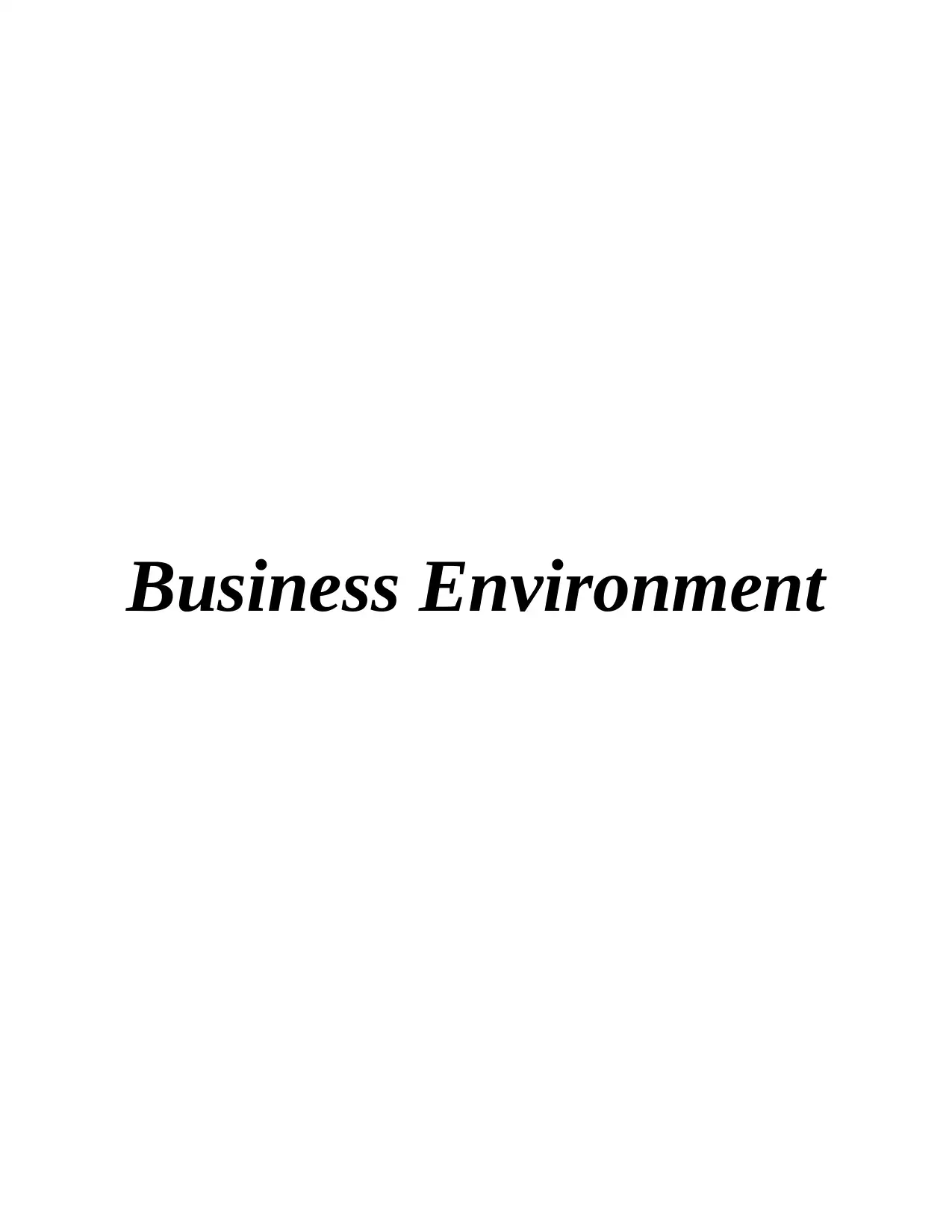
Business Environment
Paraphrase This Document
Need a fresh take? Get an instant paraphrase of this document with our AI Paraphraser
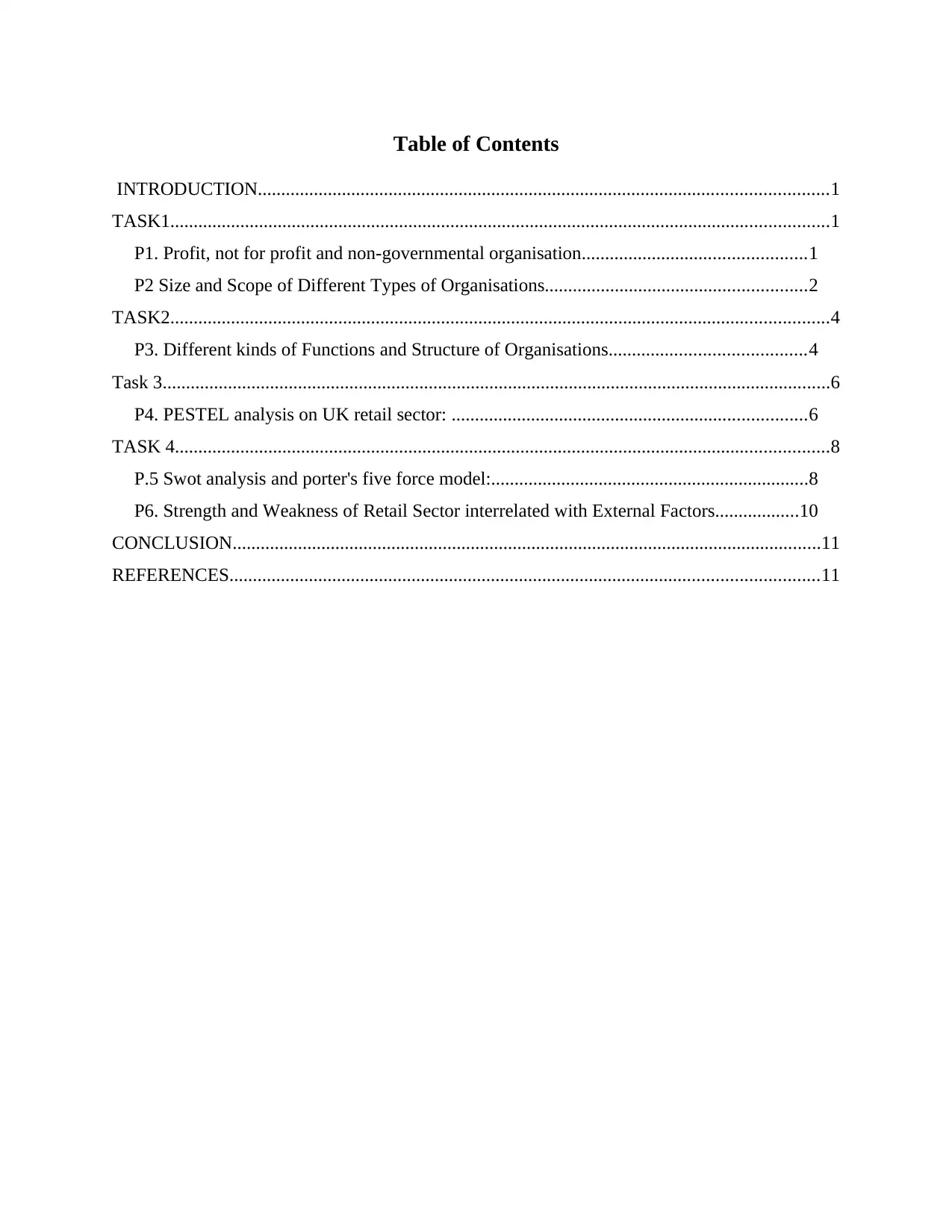
Table of Contents
INTRODUCTION..........................................................................................................................1
TASK1.............................................................................................................................................1
P1. Profit, not for profit and non-governmental organisation................................................1
P2 Size and Scope of Different Types of Organisations........................................................2
TASK2.............................................................................................................................................4
P3. Different kinds of Functions and Structure of Organisations..........................................4
Task 3...............................................................................................................................................6
P4. PESTEL analysis on UK retail sector: ............................................................................6
TASK 4............................................................................................................................................8
P.5 Swot analysis and porter's five force model:....................................................................8
P6. Strength and Weakness of Retail Sector interrelated with External Factors..................10
CONCLUSION..............................................................................................................................11
REFERENCES..............................................................................................................................11
INTRODUCTION..........................................................................................................................1
TASK1.............................................................................................................................................1
P1. Profit, not for profit and non-governmental organisation................................................1
P2 Size and Scope of Different Types of Organisations........................................................2
TASK2.............................................................................................................................................4
P3. Different kinds of Functions and Structure of Organisations..........................................4
Task 3...............................................................................................................................................6
P4. PESTEL analysis on UK retail sector: ............................................................................6
TASK 4............................................................................................................................................8
P.5 Swot analysis and porter's five force model:....................................................................8
P6. Strength and Weakness of Retail Sector interrelated with External Factors..................10
CONCLUSION..............................................................................................................................11
REFERENCES..............................................................................................................................11
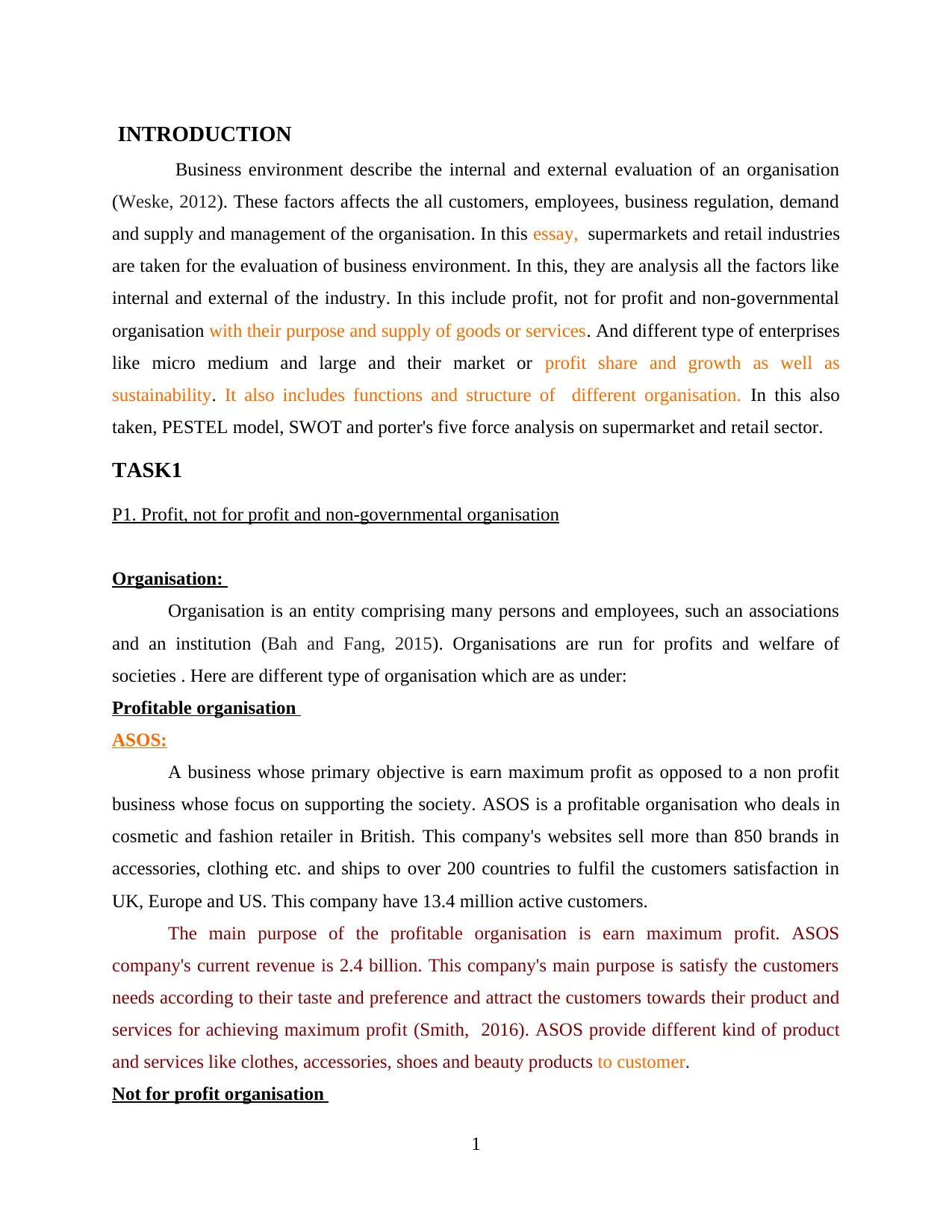
INTRODUCTION
Business environment describe the internal and external evaluation of an organisation
(Weske, 2012). These factors affects the all customers, employees, business regulation, demand
and supply and management of the organisation. In this essay, supermarkets and retail industries
are taken for the evaluation of business environment. In this, they are analysis all the factors like
internal and external of the industry. In this include profit, not for profit and non-governmental
organisation with their purpose and supply of goods or services. And different type of enterprises
like micro medium and large and their market or profit share and growth as well as
sustainability. It also includes functions and structure of different organisation. In this also
taken, PESTEL model, SWOT and porter's five force analysis on supermarket and retail sector.
TASK1
P1. Profit, not for profit and non-governmental organisation
Organisation:
Organisation is an entity comprising many persons and employees, such an associations
and an institution (Bah and Fang, 2015). Organisations are run for profits and welfare of
societies . Here are different type of organisation which are as under:
Profitable organisation
ASOS:
A business whose primary objective is earn maximum profit as opposed to a non profit
business whose focus on supporting the society. ASOS is a profitable organisation who deals in
cosmetic and fashion retailer in British. This company's websites sell more than 850 brands in
accessories, clothing etc. and ships to over 200 countries to fulfil the customers satisfaction in
UK, Europe and US. This company have 13.4 million active customers.
The main purpose of the profitable organisation is earn maximum profit. ASOS
company's current revenue is 2.4 billion. This company's main purpose is satisfy the customers
needs according to their taste and preference and attract the customers towards their product and
services for achieving maximum profit (Smith, 2016). ASOS provide different kind of product
and services like clothes, accessories, shoes and beauty products to customer.
Not for profit organisation
1
Business environment describe the internal and external evaluation of an organisation
(Weske, 2012). These factors affects the all customers, employees, business regulation, demand
and supply and management of the organisation. In this essay, supermarkets and retail industries
are taken for the evaluation of business environment. In this, they are analysis all the factors like
internal and external of the industry. In this include profit, not for profit and non-governmental
organisation with their purpose and supply of goods or services. And different type of enterprises
like micro medium and large and their market or profit share and growth as well as
sustainability. It also includes functions and structure of different organisation. In this also
taken, PESTEL model, SWOT and porter's five force analysis on supermarket and retail sector.
TASK1
P1. Profit, not for profit and non-governmental organisation
Organisation:
Organisation is an entity comprising many persons and employees, such an associations
and an institution (Bah and Fang, 2015). Organisations are run for profits and welfare of
societies . Here are different type of organisation which are as under:
Profitable organisation
ASOS:
A business whose primary objective is earn maximum profit as opposed to a non profit
business whose focus on supporting the society. ASOS is a profitable organisation who deals in
cosmetic and fashion retailer in British. This company's websites sell more than 850 brands in
accessories, clothing etc. and ships to over 200 countries to fulfil the customers satisfaction in
UK, Europe and US. This company have 13.4 million active customers.
The main purpose of the profitable organisation is earn maximum profit. ASOS
company's current revenue is 2.4 billion. This company's main purpose is satisfy the customers
needs according to their taste and preference and attract the customers towards their product and
services for achieving maximum profit (Smith, 2016). ASOS provide different kind of product
and services like clothes, accessories, shoes and beauty products to customer.
Not for profit organisation
1
⊘ This is a preview!⊘
Do you want full access?
Subscribe today to unlock all pages.

Trusted by 1+ million students worldwide
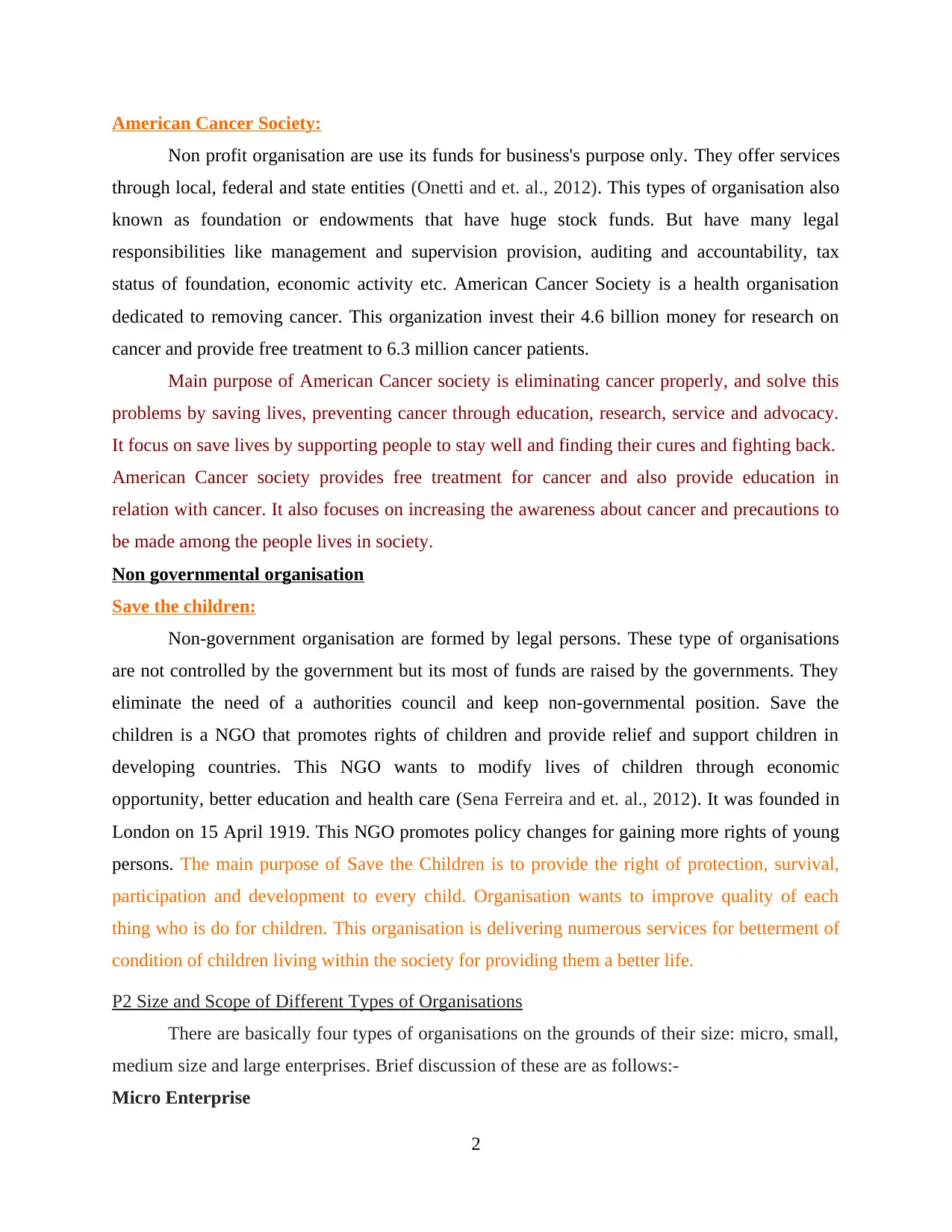
American Cancer Society:
Non profit organisation are use its funds for business's purpose only. They offer services
through local, federal and state entities (Onetti and et. al., 2012). This types of organisation also
known as foundation or endowments that have huge stock funds. But have many legal
responsibilities like management and supervision provision, auditing and accountability, tax
status of foundation, economic activity etc. American Cancer Society is a health organisation
dedicated to removing cancer. This organization invest their 4.6 billion money for research on
cancer and provide free treatment to 6.3 million cancer patients.
Main purpose of American Cancer society is eliminating cancer properly, and solve this
problems by saving lives, preventing cancer through education, research, service and advocacy.
It focus on save lives by supporting people to stay well and finding their cures and fighting back.
American Cancer society provides free treatment for cancer and also provide education in
relation with cancer. It also focuses on increasing the awareness about cancer and precautions to
be made among the people lives in society.
Non governmental organisation
Save the children:
Non-government organisation are formed by legal persons. These type of organisations
are not controlled by the government but its most of funds are raised by the governments. They
eliminate the need of a authorities council and keep non-governmental position. Save the
children is a NGO that promotes rights of children and provide relief and support children in
developing countries. This NGO wants to modify lives of children through economic
opportunity, better education and health care (Sena Ferreira and et. al., 2012). It was founded in
London on 15 April 1919. This NGO promotes policy changes for gaining more rights of young
persons. The main purpose of Save the Children is to provide the right of protection, survival,
participation and development to every child. Organisation wants to improve quality of each
thing who is do for children. This organisation is delivering numerous services for betterment of
condition of children living within the society for providing them a better life.
P2 Size and Scope of Different Types of Organisations
There are basically four types of organisations on the grounds of their size: micro, small,
medium size and large enterprises. Brief discussion of these are as follows:-
Micro Enterprise
2
Non profit organisation are use its funds for business's purpose only. They offer services
through local, federal and state entities (Onetti and et. al., 2012). This types of organisation also
known as foundation or endowments that have huge stock funds. But have many legal
responsibilities like management and supervision provision, auditing and accountability, tax
status of foundation, economic activity etc. American Cancer Society is a health organisation
dedicated to removing cancer. This organization invest their 4.6 billion money for research on
cancer and provide free treatment to 6.3 million cancer patients.
Main purpose of American Cancer society is eliminating cancer properly, and solve this
problems by saving lives, preventing cancer through education, research, service and advocacy.
It focus on save lives by supporting people to stay well and finding their cures and fighting back.
American Cancer society provides free treatment for cancer and also provide education in
relation with cancer. It also focuses on increasing the awareness about cancer and precautions to
be made among the people lives in society.
Non governmental organisation
Save the children:
Non-government organisation are formed by legal persons. These type of organisations
are not controlled by the government but its most of funds are raised by the governments. They
eliminate the need of a authorities council and keep non-governmental position. Save the
children is a NGO that promotes rights of children and provide relief and support children in
developing countries. This NGO wants to modify lives of children through economic
opportunity, better education and health care (Sena Ferreira and et. al., 2012). It was founded in
London on 15 April 1919. This NGO promotes policy changes for gaining more rights of young
persons. The main purpose of Save the Children is to provide the right of protection, survival,
participation and development to every child. Organisation wants to improve quality of each
thing who is do for children. This organisation is delivering numerous services for betterment of
condition of children living within the society for providing them a better life.
P2 Size and Scope of Different Types of Organisations
There are basically four types of organisations on the grounds of their size: micro, small,
medium size and large enterprises. Brief discussion of these are as follows:-
Micro Enterprise
2
Paraphrase This Document
Need a fresh take? Get an instant paraphrase of this document with our AI Paraphraser
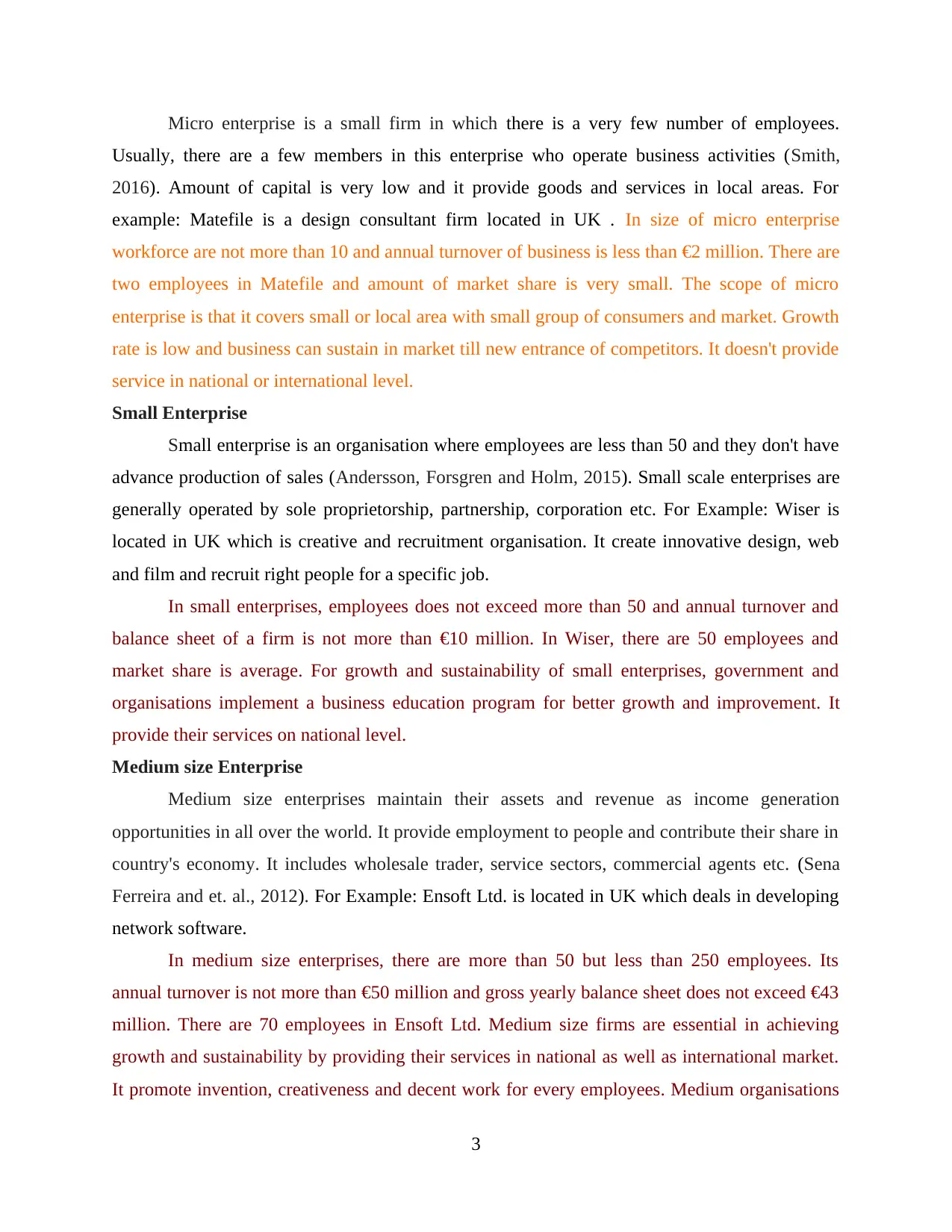
Micro enterprise is a small firm in which there is a very few number of employees.
Usually, there are a few members in this enterprise who operate business activities (Smith,
2016). Amount of capital is very low and it provide goods and services in local areas. For
example: Matefile is a design consultant firm located in UK . In size of micro enterprise
workforce are not more than 10 and annual turnover of business is less than €2 million. There are
two employees in Matefile and amount of market share is very small. The scope of micro
enterprise is that it covers small or local area with small group of consumers and market. Growth
rate is low and business can sustain in market till new entrance of competitors. It doesn't provide
service in national or international level.
Small Enterprise
Small enterprise is an organisation where employees are less than 50 and they don't have
advance production of sales (Andersson, Forsgren and Holm, 2015). Small scale enterprises are
generally operated by sole proprietorship, partnership, corporation etc. For Example: Wiser is
located in UK which is creative and recruitment organisation. It create innovative design, web
and film and recruit right people for a specific job.
In small enterprises, employees does not exceed more than 50 and annual turnover and
balance sheet of a firm is not more than €10 million. In Wiser, there are 50 employees and
market share is average. For growth and sustainability of small enterprises, government and
organisations implement a business education program for better growth and improvement. It
provide their services on national level.
Medium size Enterprise
Medium size enterprises maintain their assets and revenue as income generation
opportunities in all over the world. It provide employment to people and contribute their share in
country's economy. It includes wholesale trader, service sectors, commercial agents etc. (Sena
Ferreira and et. al., 2012). For Example: Ensoft Ltd. is located in UK which deals in developing
network software.
In medium size enterprises, there are more than 50 but less than 250 employees. Its
annual turnover is not more than €50 million and gross yearly balance sheet does not exceed €43
million. There are 70 employees in Ensoft Ltd. Medium size firms are essential in achieving
growth and sustainability by providing their services in national as well as international market.
It promote invention, creativeness and decent work for every employees. Medium organisations
3
Usually, there are a few members in this enterprise who operate business activities (Smith,
2016). Amount of capital is very low and it provide goods and services in local areas. For
example: Matefile is a design consultant firm located in UK . In size of micro enterprise
workforce are not more than 10 and annual turnover of business is less than €2 million. There are
two employees in Matefile and amount of market share is very small. The scope of micro
enterprise is that it covers small or local area with small group of consumers and market. Growth
rate is low and business can sustain in market till new entrance of competitors. It doesn't provide
service in national or international level.
Small Enterprise
Small enterprise is an organisation where employees are less than 50 and they don't have
advance production of sales (Andersson, Forsgren and Holm, 2015). Small scale enterprises are
generally operated by sole proprietorship, partnership, corporation etc. For Example: Wiser is
located in UK which is creative and recruitment organisation. It create innovative design, web
and film and recruit right people for a specific job.
In small enterprises, employees does not exceed more than 50 and annual turnover and
balance sheet of a firm is not more than €10 million. In Wiser, there are 50 employees and
market share is average. For growth and sustainability of small enterprises, government and
organisations implement a business education program for better growth and improvement. It
provide their services on national level.
Medium size Enterprise
Medium size enterprises maintain their assets and revenue as income generation
opportunities in all over the world. It provide employment to people and contribute their share in
country's economy. It includes wholesale trader, service sectors, commercial agents etc. (Sena
Ferreira and et. al., 2012). For Example: Ensoft Ltd. is located in UK which deals in developing
network software.
In medium size enterprises, there are more than 50 but less than 250 employees. Its
annual turnover is not more than €50 million and gross yearly balance sheet does not exceed €43
million. There are 70 employees in Ensoft Ltd. Medium size firms are essential in achieving
growth and sustainability by providing their services in national as well as international market.
It promote invention, creativeness and decent work for every employees. Medium organisations
3
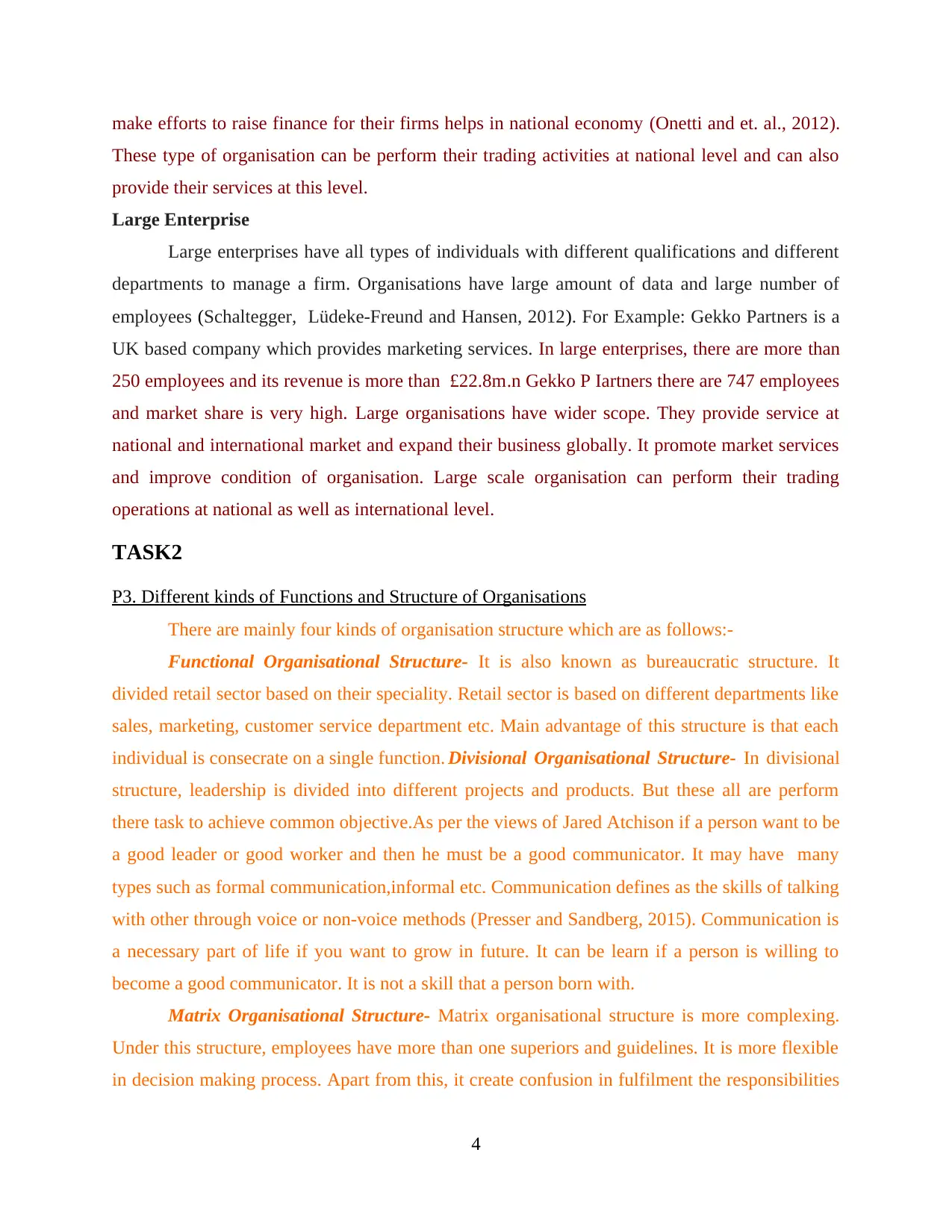
make efforts to raise finance for their firms helps in national economy (Onetti and et. al., 2012).
These type of organisation can be perform their trading activities at national level and can also
provide their services at this level.
Large Enterprise
Large enterprises have all types of individuals with different qualifications and different
departments to manage a firm. Organisations have large amount of data and large number of
employees (Schaltegger, Lüdeke-Freund and Hansen, 2012). For Example: Gekko Partners is a
UK based company which provides marketing services. In large enterprises, there are more than
250 employees and its revenue is more than £22.8m.n Gekko P Iartners there are 747 employees
and market share is very high. Large organisations have wider scope. They provide service at
national and international market and expand their business globally. It promote market services
and improve condition of organisation. Large scale organisation can perform their trading
operations at national as well as international level.
TASK2
P3. Different kinds of Functions and Structure of Organisations
There are mainly four kinds of organisation structure which are as follows:-
Functional Organisational Structure- It is also known as bureaucratic structure. It
divided retail sector based on their speciality. Retail sector is based on different departments like
sales, marketing, customer service department etc. Main advantage of this structure is that each
individual is consecrate on a single function. Divisional Organisational Structure- In divisional
structure, leadership is divided into different projects and products. But these all are perform
there task to achieve common objective.As per the views of Jared Atchison if a person want to be
a good leader or good worker and then he must be a good communicator. It may have many
types such as formal communication,informal etc. Communication defines as the skills of talking
with other through voice or non-voice methods (Presser and Sandberg, 2015). Communication is
a necessary part of life if you want to grow in future. It can be learn if a person is willing to
become a good communicator. It is not a skill that a person born with.
Matrix Organisational Structure- Matrix organisational structure is more complexing.
Under this structure, employees have more than one superiors and guidelines. It is more flexible
in decision making process. Apart from this, it create confusion in fulfilment the responsibilities
4
These type of organisation can be perform their trading activities at national level and can also
provide their services at this level.
Large Enterprise
Large enterprises have all types of individuals with different qualifications and different
departments to manage a firm. Organisations have large amount of data and large number of
employees (Schaltegger, Lüdeke-Freund and Hansen, 2012). For Example: Gekko Partners is a
UK based company which provides marketing services. In large enterprises, there are more than
250 employees and its revenue is more than £22.8m.n Gekko P Iartners there are 747 employees
and market share is very high. Large organisations have wider scope. They provide service at
national and international market and expand their business globally. It promote market services
and improve condition of organisation. Large scale organisation can perform their trading
operations at national as well as international level.
TASK2
P3. Different kinds of Functions and Structure of Organisations
There are mainly four kinds of organisation structure which are as follows:-
Functional Organisational Structure- It is also known as bureaucratic structure. It
divided retail sector based on their speciality. Retail sector is based on different departments like
sales, marketing, customer service department etc. Main advantage of this structure is that each
individual is consecrate on a single function. Divisional Organisational Structure- In divisional
structure, leadership is divided into different projects and products. But these all are perform
there task to achieve common objective.As per the views of Jared Atchison if a person want to be
a good leader or good worker and then he must be a good communicator. It may have many
types such as formal communication,informal etc. Communication defines as the skills of talking
with other through voice or non-voice methods (Presser and Sandberg, 2015). Communication is
a necessary part of life if you want to grow in future. It can be learn if a person is willing to
become a good communicator. It is not a skill that a person born with.
Matrix Organisational Structure- Matrix organisational structure is more complexing.
Under this structure, employees have more than one superiors and guidelines. It is more flexible
in decision making process. Apart from this, it create confusion in fulfilment the responsibilities
4
⊘ This is a preview!⊘
Do you want full access?
Subscribe today to unlock all pages.

Trusted by 1+ million students worldwide
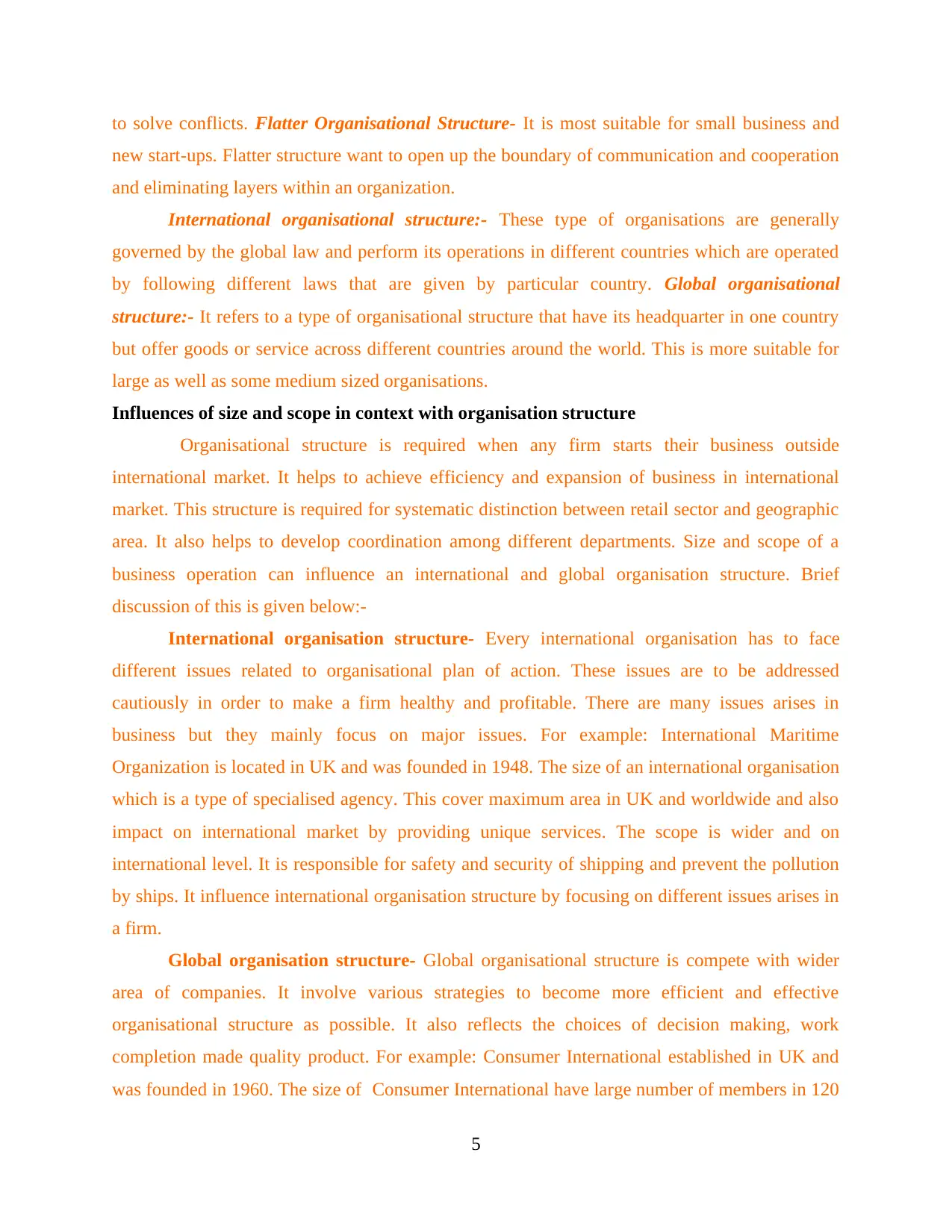
to solve conflicts. Flatter Organisational Structure- It is most suitable for small business and
new start-ups. Flatter structure want to open up the boundary of communication and cooperation
and eliminating layers within an organization.
International organisational structure:- These type of organisations are generally
governed by the global law and perform its operations in different countries which are operated
by following different laws that are given by particular country. Global organisational
structure:- It refers to a type of organisational structure that have its headquarter in one country
but offer goods or service across different countries around the world. This is more suitable for
large as well as some medium sized organisations.
Influences of size and scope in context with organisation structure
Organisational structure is required when any firm starts their business outside
international market. It helps to achieve efficiency and expansion of business in international
market. This structure is required for systematic distinction between retail sector and geographic
area. It also helps to develop coordination among different departments. Size and scope of a
business operation can influence an international and global organisation structure. Brief
discussion of this is given below:-
International organisation structure- Every international organisation has to face
different issues related to organisational plan of action. These issues are to be addressed
cautiously in order to make a firm healthy and profitable. There are many issues arises in
business but they mainly focus on major issues. For example: International Maritime
Organization is located in UK and was founded in 1948. The size of an international organisation
which is a type of specialised agency. This cover maximum area in UK and worldwide and also
impact on international market by providing unique services. The scope is wider and on
international level. It is responsible for safety and security of shipping and prevent the pollution
by ships. It influence international organisation structure by focusing on different issues arises in
a firm.
Global organisation structure- Global organisational structure is compete with wider
area of companies. It involve various strategies to become more efficient and effective
organisational structure as possible. It also reflects the choices of decision making, work
completion made quality product. For example: Consumer International established in UK and
was founded in 1960. The size of Consumer International have large number of members in 120
5
new start-ups. Flatter structure want to open up the boundary of communication and cooperation
and eliminating layers within an organization.
International organisational structure:- These type of organisations are generally
governed by the global law and perform its operations in different countries which are operated
by following different laws that are given by particular country. Global organisational
structure:- It refers to a type of organisational structure that have its headquarter in one country
but offer goods or service across different countries around the world. This is more suitable for
large as well as some medium sized organisations.
Influences of size and scope in context with organisation structure
Organisational structure is required when any firm starts their business outside
international market. It helps to achieve efficiency and expansion of business in international
market. This structure is required for systematic distinction between retail sector and geographic
area. It also helps to develop coordination among different departments. Size and scope of a
business operation can influence an international and global organisation structure. Brief
discussion of this is given below:-
International organisation structure- Every international organisation has to face
different issues related to organisational plan of action. These issues are to be addressed
cautiously in order to make a firm healthy and profitable. There are many issues arises in
business but they mainly focus on major issues. For example: International Maritime
Organization is located in UK and was founded in 1948. The size of an international organisation
which is a type of specialised agency. This cover maximum area in UK and worldwide and also
impact on international market by providing unique services. The scope is wider and on
international level. It is responsible for safety and security of shipping and prevent the pollution
by ships. It influence international organisation structure by focusing on different issues arises in
a firm.
Global organisation structure- Global organisational structure is compete with wider
area of companies. It involve various strategies to become more efficient and effective
organisational structure as possible. It also reflects the choices of decision making, work
completion made quality product. For example: Consumer International established in UK and
was founded in 1960. The size of Consumer International have large number of members in 120
5
Paraphrase This Document
Need a fresh take? Get an instant paraphrase of this document with our AI Paraphraser
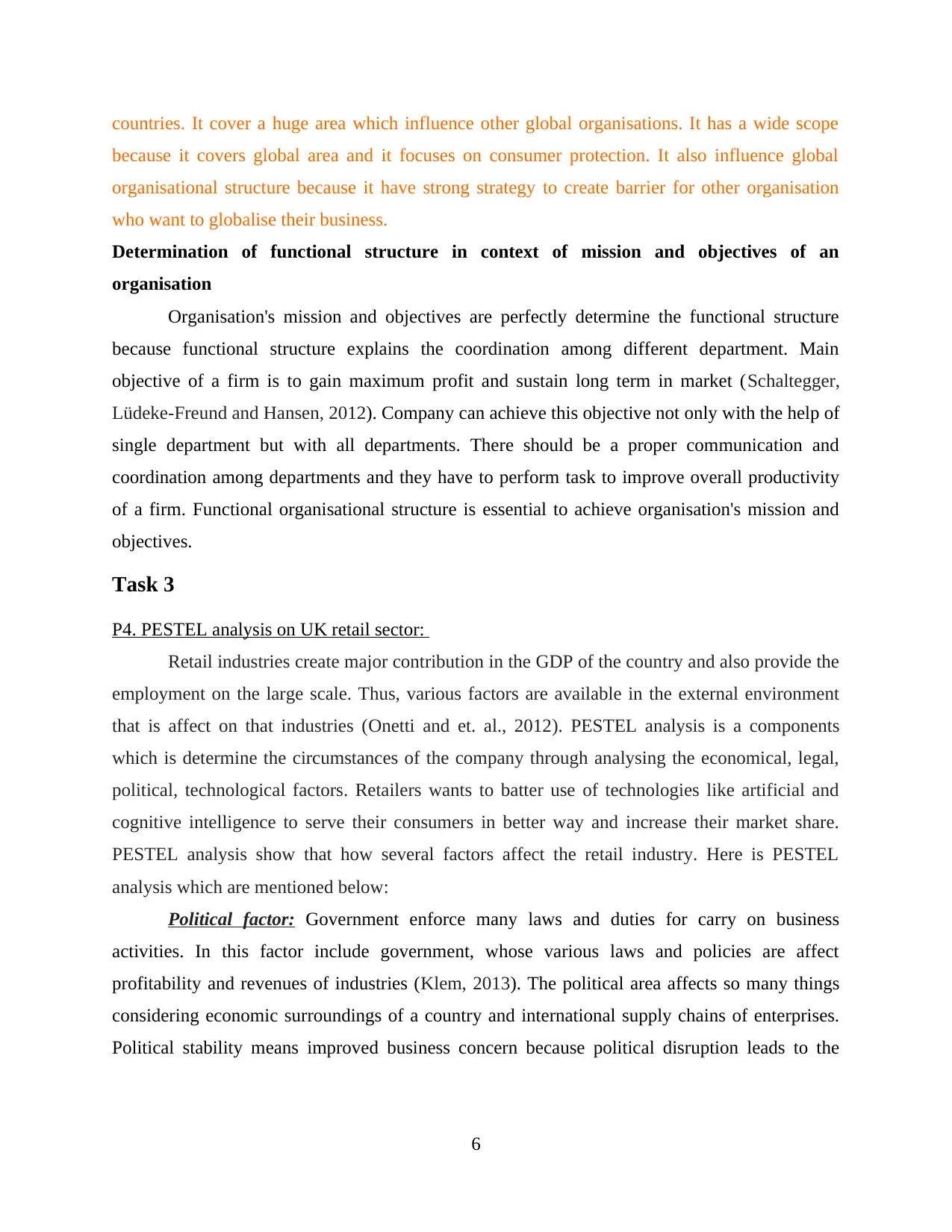
countries. It cover a huge area which influence other global organisations. It has a wide scope
because it covers global area and it focuses on consumer protection. It also influence global
organisational structure because it have strong strategy to create barrier for other organisation
who want to globalise their business.
Determination of functional structure in context of mission and objectives of an
organisation
Organisation's mission and objectives are perfectly determine the functional structure
because functional structure explains the coordination among different department. Main
objective of a firm is to gain maximum profit and sustain long term in market (Schaltegger,
Lüdeke-Freund and Hansen, 2012). Company can achieve this objective not only with the help of
single department but with all departments. There should be a proper communication and
coordination among departments and they have to perform task to improve overall productivity
of a firm. Functional organisational structure is essential to achieve organisation's mission and
objectives.
Task 3
P4. PESTEL analysis on UK retail sector:
Retail industries create major contribution in the GDP of the country and also provide the
employment on the large scale. Thus, various factors are available in the external environment
that is affect on that industries (Onetti and et. al., 2012). PESTEL analysis is a components
which is determine the circumstances of the company through analysing the economical, legal,
political, technological factors. Retailers wants to batter use of technologies like artificial and
cognitive intelligence to serve their consumers in better way and increase their market share.
PESTEL analysis show that how several factors affect the retail industry. Here is PESTEL
analysis which are mentioned below:
Political factor: Government enforce many laws and duties for carry on business
activities. In this factor include government, whose various laws and policies are affect
profitability and revenues of industries (Klem, 2013). The political area affects so many things
considering economic surroundings of a country and international supply chains of enterprises.
Political stability means improved business concern because political disruption leads to the
6
because it covers global area and it focuses on consumer protection. It also influence global
organisational structure because it have strong strategy to create barrier for other organisation
who want to globalise their business.
Determination of functional structure in context of mission and objectives of an
organisation
Organisation's mission and objectives are perfectly determine the functional structure
because functional structure explains the coordination among different department. Main
objective of a firm is to gain maximum profit and sustain long term in market (Schaltegger,
Lüdeke-Freund and Hansen, 2012). Company can achieve this objective not only with the help of
single department but with all departments. There should be a proper communication and
coordination among departments and they have to perform task to improve overall productivity
of a firm. Functional organisational structure is essential to achieve organisation's mission and
objectives.
Task 3
P4. PESTEL analysis on UK retail sector:
Retail industries create major contribution in the GDP of the country and also provide the
employment on the large scale. Thus, various factors are available in the external environment
that is affect on that industries (Onetti and et. al., 2012). PESTEL analysis is a components
which is determine the circumstances of the company through analysing the economical, legal,
political, technological factors. Retailers wants to batter use of technologies like artificial and
cognitive intelligence to serve their consumers in better way and increase their market share.
PESTEL analysis show that how several factors affect the retail industry. Here is PESTEL
analysis which are mentioned below:
Political factor: Government enforce many laws and duties for carry on business
activities. In this factor include government, whose various laws and policies are affect
profitability and revenues of industries (Klem, 2013). The political area affects so many things
considering economic surroundings of a country and international supply chains of enterprises.
Political stability means improved business concern because political disruption leads to the
6
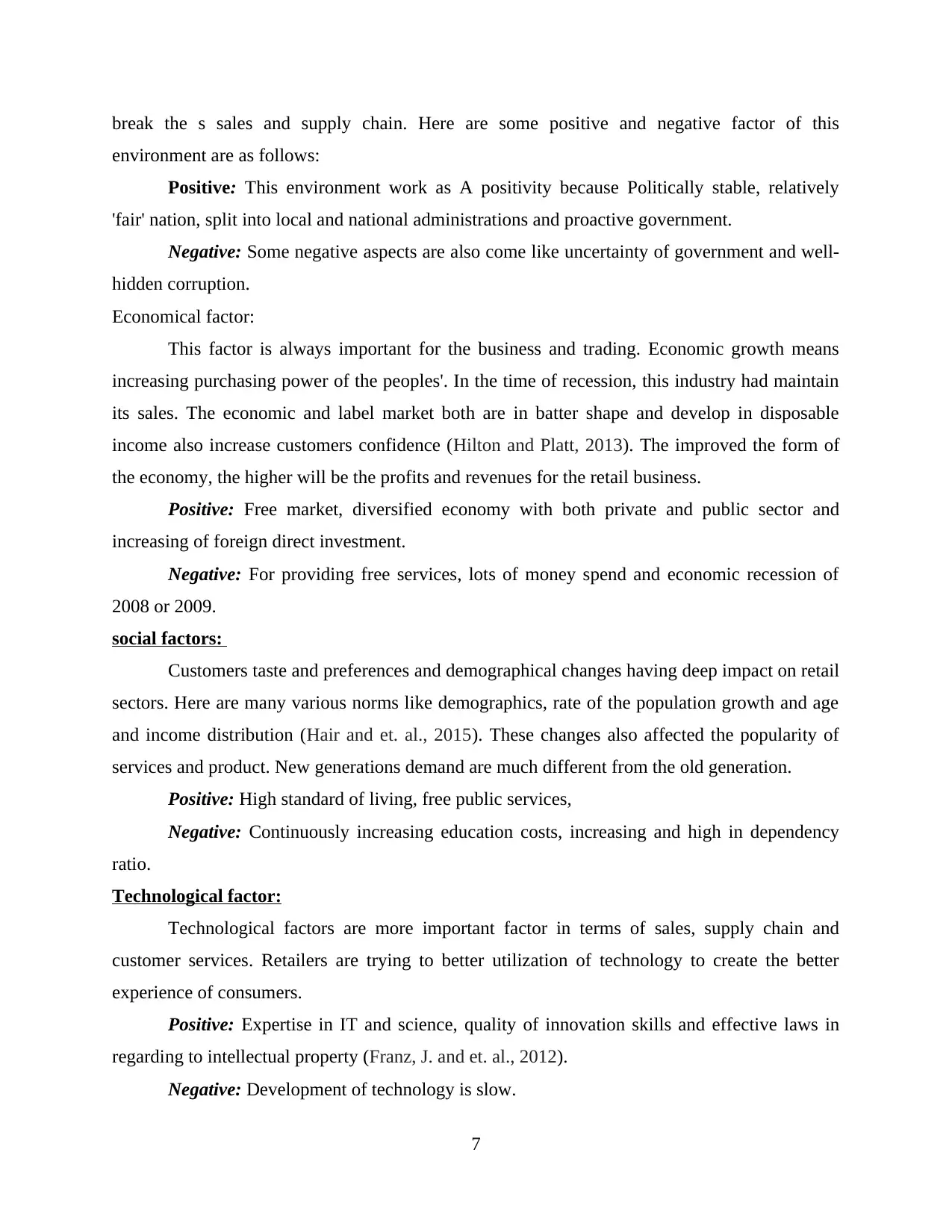
break the s sales and supply chain. Here are some positive and negative factor of this
environment are as follows:
Positive: This environment work as A positivity because Politically stable, relatively
'fair' nation, split into local and national administrations and proactive government.
Negative: Some negative aspects are also come like uncertainty of government and well-
hidden corruption.
Economical factor:
This factor is always important for the business and trading. Economic growth means
increasing purchasing power of the peoples'. In the time of recession, this industry had maintain
its sales. The economic and label market both are in batter shape and develop in disposable
income also increase customers confidence (Hilton and Platt, 2013). The improved the form of
the economy, the higher will be the profits and revenues for the retail business.
Positive: Free market, diversified economy with both private and public sector and
increasing of foreign direct investment.
Negative: For providing free services, lots of money spend and economic recession of
2008 or 2009.
social factors:
Customers taste and preferences and demographical changes having deep impact on retail
sectors. Here are many various norms like demographics, rate of the population growth and age
and income distribution (Hair and et. al., 2015). These changes also affected the popularity of
services and product. New generations demand are much different from the old generation.
Positive: High standard of living, free public services,
Negative: Continuously increasing education costs, increasing and high in dependency
ratio.
Technological factor:
Technological factors are more important factor in terms of sales, supply chain and
customer services. Retailers are trying to better utilization of technology to create the better
experience of consumers.
Positive: Expertise in IT and science, quality of innovation skills and effective laws in
regarding to intellectual property (Franz, J. and et. al., 2012).
Negative: Development of technology is slow.
7
environment are as follows:
Positive: This environment work as A positivity because Politically stable, relatively
'fair' nation, split into local and national administrations and proactive government.
Negative: Some negative aspects are also come like uncertainty of government and well-
hidden corruption.
Economical factor:
This factor is always important for the business and trading. Economic growth means
increasing purchasing power of the peoples'. In the time of recession, this industry had maintain
its sales. The economic and label market both are in batter shape and develop in disposable
income also increase customers confidence (Hilton and Platt, 2013). The improved the form of
the economy, the higher will be the profits and revenues for the retail business.
Positive: Free market, diversified economy with both private and public sector and
increasing of foreign direct investment.
Negative: For providing free services, lots of money spend and economic recession of
2008 or 2009.
social factors:
Customers taste and preferences and demographical changes having deep impact on retail
sectors. Here are many various norms like demographics, rate of the population growth and age
and income distribution (Hair and et. al., 2015). These changes also affected the popularity of
services and product. New generations demand are much different from the old generation.
Positive: High standard of living, free public services,
Negative: Continuously increasing education costs, increasing and high in dependency
ratio.
Technological factor:
Technological factors are more important factor in terms of sales, supply chain and
customer services. Retailers are trying to better utilization of technology to create the better
experience of consumers.
Positive: Expertise in IT and science, quality of innovation skills and effective laws in
regarding to intellectual property (Franz, J. and et. al., 2012).
Negative: Development of technology is slow.
7
⊘ This is a preview!⊘
Do you want full access?
Subscribe today to unlock all pages.

Trusted by 1+ million students worldwide
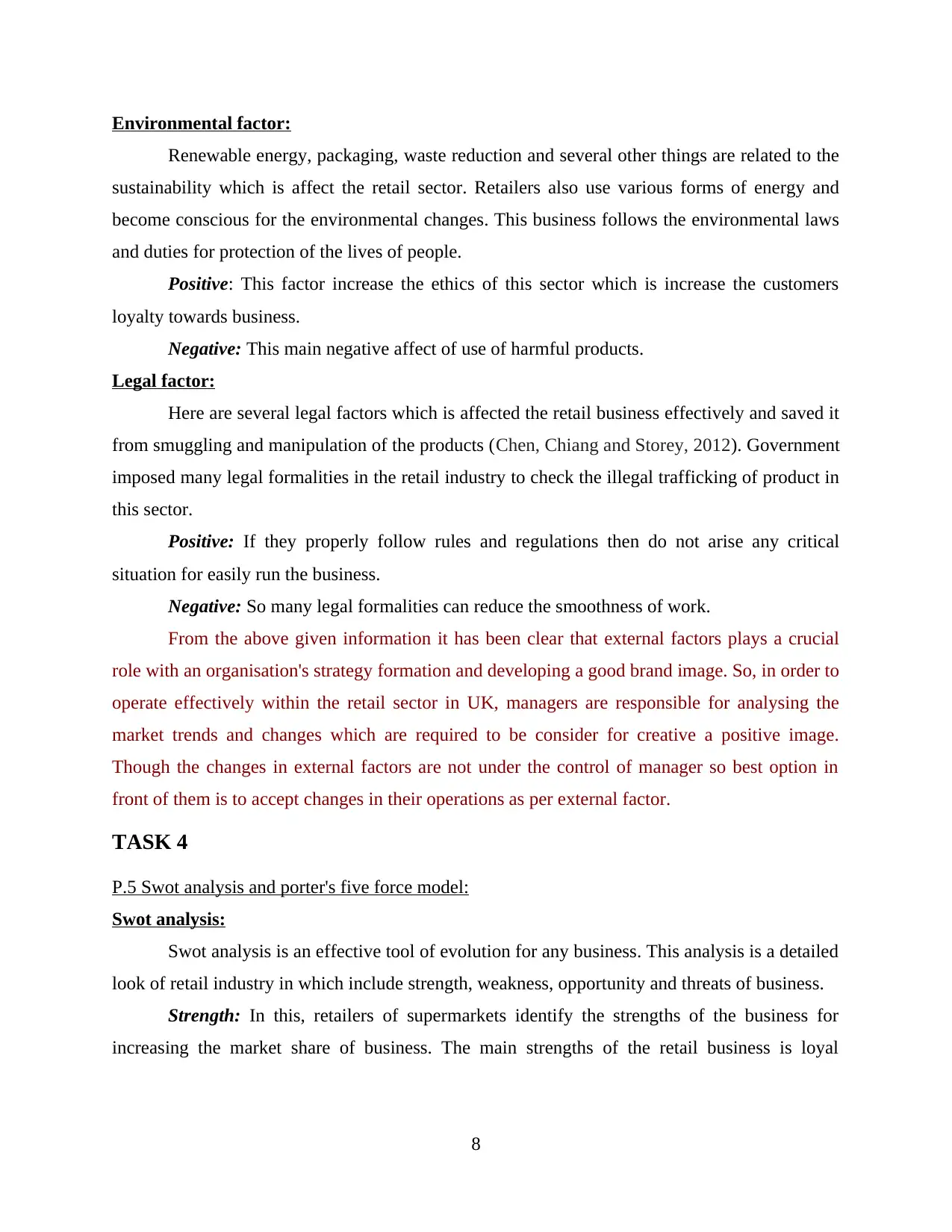
Environmental factor:
Renewable energy, packaging, waste reduction and several other things are related to the
sustainability which is affect the retail sector. Retailers also use various forms of energy and
become conscious for the environmental changes. This business follows the environmental laws
and duties for protection of the lives of people.
Positive: This factor increase the ethics of this sector which is increase the customers
loyalty towards business.
Negative: This main negative affect of use of harmful products.
Legal factor:
Here are several legal factors which is affected the retail business effectively and saved it
from smuggling and manipulation of the products (Chen, Chiang and Storey, 2012). Government
imposed many legal formalities in the retail industry to check the illegal trafficking of product in
this sector.
Positive: If they properly follow rules and regulations then do not arise any critical
situation for easily run the business.
Negative: So many legal formalities can reduce the smoothness of work.
From the above given information it has been clear that external factors plays a crucial
role with an organisation's strategy formation and developing a good brand image. So, in order to
operate effectively within the retail sector in UK, managers are responsible for analysing the
market trends and changes which are required to be consider for creative a positive image.
Though the changes in external factors are not under the control of manager so best option in
front of them is to accept changes in their operations as per external factor.
TASK 4
P.5 Swot analysis and porter's five force model:
Swot analysis:
Swot analysis is an effective tool of evolution for any business. This analysis is a detailed
look of retail industry in which include strength, weakness, opportunity and threats of business.
Strength: In this, retailers of supermarkets identify the strengths of the business for
increasing the market share of business. The main strengths of the retail business is loyal
8
Renewable energy, packaging, waste reduction and several other things are related to the
sustainability which is affect the retail sector. Retailers also use various forms of energy and
become conscious for the environmental changes. This business follows the environmental laws
and duties for protection of the lives of people.
Positive: This factor increase the ethics of this sector which is increase the customers
loyalty towards business.
Negative: This main negative affect of use of harmful products.
Legal factor:
Here are several legal factors which is affected the retail business effectively and saved it
from smuggling and manipulation of the products (Chen, Chiang and Storey, 2012). Government
imposed many legal formalities in the retail industry to check the illegal trafficking of product in
this sector.
Positive: If they properly follow rules and regulations then do not arise any critical
situation for easily run the business.
Negative: So many legal formalities can reduce the smoothness of work.
From the above given information it has been clear that external factors plays a crucial
role with an organisation's strategy formation and developing a good brand image. So, in order to
operate effectively within the retail sector in UK, managers are responsible for analysing the
market trends and changes which are required to be consider for creative a positive image.
Though the changes in external factors are not under the control of manager so best option in
front of them is to accept changes in their operations as per external factor.
TASK 4
P.5 Swot analysis and porter's five force model:
Swot analysis:
Swot analysis is an effective tool of evolution for any business. This analysis is a detailed
look of retail industry in which include strength, weakness, opportunity and threats of business.
Strength: In this, retailers of supermarkets identify the strengths of the business for
increasing the market share of business. The main strengths of the retail business is loyal
8
Paraphrase This Document
Need a fresh take? Get an instant paraphrase of this document with our AI Paraphraser
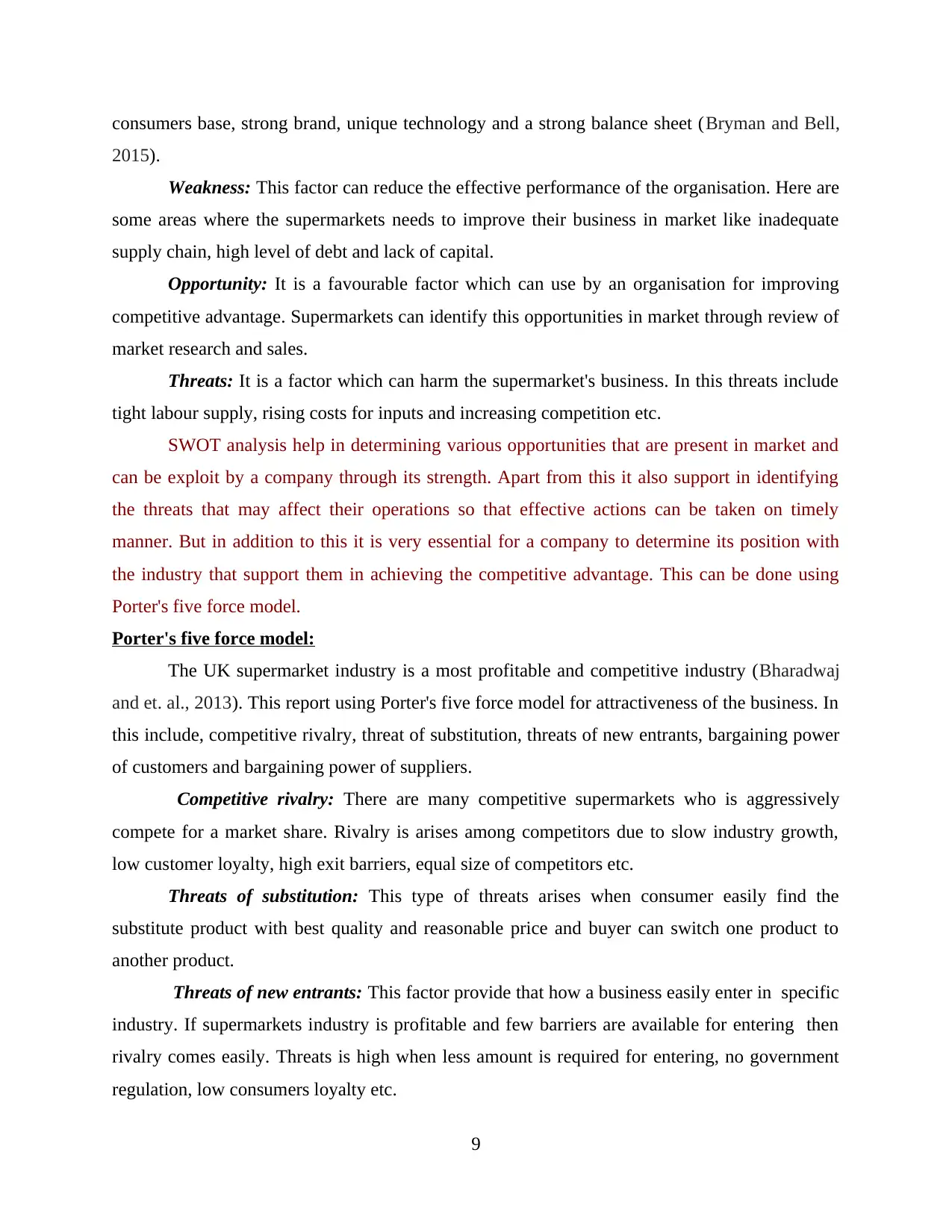
consumers base, strong brand, unique technology and a strong balance sheet (Bryman and Bell,
2015).
Weakness: This factor can reduce the effective performance of the organisation. Here are
some areas where the supermarkets needs to improve their business in market like inadequate
supply chain, high level of debt and lack of capital.
Opportunity: It is a favourable factor which can use by an organisation for improving
competitive advantage. Supermarkets can identify this opportunities in market through review of
market research and sales.
Threats: It is a factor which can harm the supermarket's business. In this threats include
tight labour supply, rising costs for inputs and increasing competition etc.
SWOT analysis help in determining various opportunities that are present in market and
can be exploit by a company through its strength. Apart from this it also support in identifying
the threats that may affect their operations so that effective actions can be taken on timely
manner. But in addition to this it is very essential for a company to determine its position with
the industry that support them in achieving the competitive advantage. This can be done using
Porter's five force model.
Porter's five force model:
The UK supermarket industry is a most profitable and competitive industry (Bharadwaj
and et. al., 2013). This report using Porter's five force model for attractiveness of the business. In
this include, competitive rivalry, threat of substitution, threats of new entrants, bargaining power
of customers and bargaining power of suppliers.
Competitive rivalry: There are many competitive supermarkets who is aggressively
compete for a market share. Rivalry is arises among competitors due to slow industry growth,
low customer loyalty, high exit barriers, equal size of competitors etc.
Threats of substitution: This type of threats arises when consumer easily find the
substitute product with best quality and reasonable price and buyer can switch one product to
another product.
Threats of new entrants: This factor provide that how a business easily enter in specific
industry. If supermarkets industry is profitable and few barriers are available for entering then
rivalry comes easily. Threats is high when less amount is required for entering, no government
regulation, low consumers loyalty etc.
9
2015).
Weakness: This factor can reduce the effective performance of the organisation. Here are
some areas where the supermarkets needs to improve their business in market like inadequate
supply chain, high level of debt and lack of capital.
Opportunity: It is a favourable factor which can use by an organisation for improving
competitive advantage. Supermarkets can identify this opportunities in market through review of
market research and sales.
Threats: It is a factor which can harm the supermarket's business. In this threats include
tight labour supply, rising costs for inputs and increasing competition etc.
SWOT analysis help in determining various opportunities that are present in market and
can be exploit by a company through its strength. Apart from this it also support in identifying
the threats that may affect their operations so that effective actions can be taken on timely
manner. But in addition to this it is very essential for a company to determine its position with
the industry that support them in achieving the competitive advantage. This can be done using
Porter's five force model.
Porter's five force model:
The UK supermarket industry is a most profitable and competitive industry (Bharadwaj
and et. al., 2013). This report using Porter's five force model for attractiveness of the business. In
this include, competitive rivalry, threat of substitution, threats of new entrants, bargaining power
of customers and bargaining power of suppliers.
Competitive rivalry: There are many competitive supermarkets who is aggressively
compete for a market share. Rivalry is arises among competitors due to slow industry growth,
low customer loyalty, high exit barriers, equal size of competitors etc.
Threats of substitution: This type of threats arises when consumer easily find the
substitute product with best quality and reasonable price and buyer can switch one product to
another product.
Threats of new entrants: This factor provide that how a business easily enter in specific
industry. If supermarkets industry is profitable and few barriers are available for entering then
rivalry comes easily. Threats is high when less amount is required for entering, no government
regulation, low consumers loyalty etc.
9
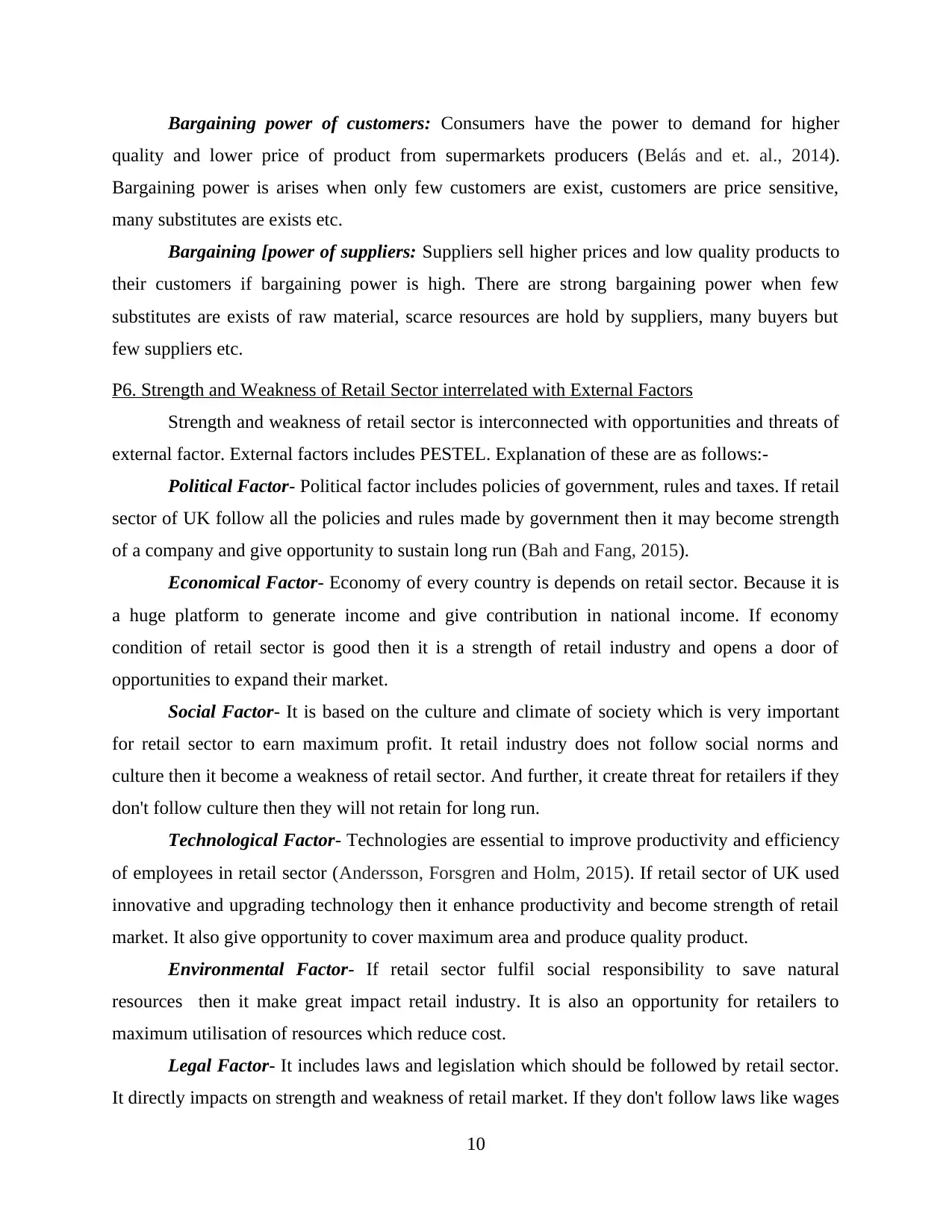
Bargaining power of customers: Consumers have the power to demand for higher
quality and lower price of product from supermarkets producers (Belás and et. al., 2014).
Bargaining power is arises when only few customers are exist, customers are price sensitive,
many substitutes are exists etc.
Bargaining [power of suppliers: Suppliers sell higher prices and low quality products to
their customers if bargaining power is high. There are strong bargaining power when few
substitutes are exists of raw material, scarce resources are hold by suppliers, many buyers but
few suppliers etc.
P6. Strength and Weakness of Retail Sector interrelated with External Factors
Strength and weakness of retail sector is interconnected with opportunities and threats of
external factor. External factors includes PESTEL. Explanation of these are as follows:-
Political Factor- Political factor includes policies of government, rules and taxes. If retail
sector of UK follow all the policies and rules made by government then it may become strength
of a company and give opportunity to sustain long run (Bah and Fang, 2015).
Economical Factor- Economy of every country is depends on retail sector. Because it is
a huge platform to generate income and give contribution in national income. If economy
condition of retail sector is good then it is a strength of retail industry and opens a door of
opportunities to expand their market.
Social Factor- It is based on the culture and climate of society which is very important
for retail sector to earn maximum profit. It retail industry does not follow social norms and
culture then it become a weakness of retail sector. And further, it create threat for retailers if they
don't follow culture then they will not retain for long run.
Technological Factor- Technologies are essential to improve productivity and efficiency
of employees in retail sector (Andersson, Forsgren and Holm, 2015). If retail sector of UK used
innovative and upgrading technology then it enhance productivity and become strength of retail
market. It also give opportunity to cover maximum area and produce quality product.
Environmental Factor- If retail sector fulfil social responsibility to save natural
resources then it make great impact retail industry. It is also an opportunity for retailers to
maximum utilisation of resources which reduce cost.
Legal Factor- It includes laws and legislation which should be followed by retail sector.
It directly impacts on strength and weakness of retail market. If they don't follow laws like wages
10
quality and lower price of product from supermarkets producers (Belás and et. al., 2014).
Bargaining power is arises when only few customers are exist, customers are price sensitive,
many substitutes are exists etc.
Bargaining [power of suppliers: Suppliers sell higher prices and low quality products to
their customers if bargaining power is high. There are strong bargaining power when few
substitutes are exists of raw material, scarce resources are hold by suppliers, many buyers but
few suppliers etc.
P6. Strength and Weakness of Retail Sector interrelated with External Factors
Strength and weakness of retail sector is interconnected with opportunities and threats of
external factor. External factors includes PESTEL. Explanation of these are as follows:-
Political Factor- Political factor includes policies of government, rules and taxes. If retail
sector of UK follow all the policies and rules made by government then it may become strength
of a company and give opportunity to sustain long run (Bah and Fang, 2015).
Economical Factor- Economy of every country is depends on retail sector. Because it is
a huge platform to generate income and give contribution in national income. If economy
condition of retail sector is good then it is a strength of retail industry and opens a door of
opportunities to expand their market.
Social Factor- It is based on the culture and climate of society which is very important
for retail sector to earn maximum profit. It retail industry does not follow social norms and
culture then it become a weakness of retail sector. And further, it create threat for retailers if they
don't follow culture then they will not retain for long run.
Technological Factor- Technologies are essential to improve productivity and efficiency
of employees in retail sector (Andersson, Forsgren and Holm, 2015). If retail sector of UK used
innovative and upgrading technology then it enhance productivity and become strength of retail
market. It also give opportunity to cover maximum area and produce quality product.
Environmental Factor- If retail sector fulfil social responsibility to save natural
resources then it make great impact retail industry. It is also an opportunity for retailers to
maximum utilisation of resources which reduce cost.
Legal Factor- It includes laws and legislation which should be followed by retail sector.
It directly impacts on strength and weakness of retail market. If they don't follow laws like wages
10
⊘ This is a preview!⊘
Do you want full access?
Subscribe today to unlock all pages.

Trusted by 1+ million students worldwide
1 out of 14
Related Documents
Your All-in-One AI-Powered Toolkit for Academic Success.
+13062052269
info@desklib.com
Available 24*7 on WhatsApp / Email
![[object Object]](/_next/static/media/star-bottom.7253800d.svg)
Unlock your academic potential
Copyright © 2020–2025 A2Z Services. All Rights Reserved. Developed and managed by ZUCOL.



